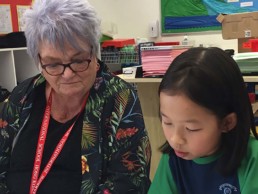Be the Teacher
The following blog is one of a series linked to the Talk:Write Programme to improve children’s oratory and writing. The series includes:
Be the Speaker: improve children’s confidence, clarity, correct use of English and skills of oratory as a speaker.
Be the Teacher: empower children to correct their own and other’s grammar and pronunciation in speech, or grammar, spelling and punctuation in writing.
Be Word Wise: enrich children’s vocabulary with a wide range of suave words that they know, understand, can spell and can use correctly in appropriate contexts.
‘Be the Teacher’ is a simple, fun and effective way for children to achieve multiple exposures / opportunities to embed new language features or correct use of English in line with the research quoted in the ‘Talk:Write’ programme.
The aim of ‘Be the Teacher’ is for children to take on the role of the marker, proof-reader or audio-checker for their peer or peers, and behaving like a teacher through offering advice and corrections as necessary and when able.
This activity can be ‘played’ in several ways. All are fully adaptable and do not have to be pursued in exactly the same ways as described below. They can, also, be ‘played’ as stand alone activities in classes or schools not implementing the Talk:Write programme, however greater impact will be seen, and at much greater speed, when the programme is fully implemented.
- Be the Teacher: Spot the slips in Standard English during discussion and teaching within the class.
- Be the Teacher: Spot the slips in Standard English with pre-primed visitors to the classroom.
- Be the Teacher: Spot the slips in Bud’s writing.
- Be the Teacher: Spot the teacher’s slips in writing on the whiteboard working with your writing partner.
- Be the Teacher: Spot the slips in your writing partner’s work.
- Be the Teacher: Spot the slips on whiteboards or handouts.
1. Be the Teacher: Spot the Slips in Standard English Within the Class
I recommend this is the first ‘Be the Teacher’ activity to be introduced and that it should be launched as soon as the teacher starts to address the issues around all children speaking in Standard English.
The teacher should model some of the differences in sentence structure between Standard English and most strong accents or dialects. There are free resources for Talk:Write subscribers on the website that give many examples of the types of errors children need to watch out for when striving for Standard English, the most common being the noun/verb mismatches such as ‘we was’, ‘I were’ and ‘them are’.
I suggest that several times a week, the teacher should warn the children that they are going to intentionally make some mistakes as they talk. This could be in the introduction or conclusion of any lesson in any subject, so that the time taken to do this is subject-specific time. If the children think they have spotted a mistake they must shoot their hands up. The teacher will ask the first child to say what the mistake was and what the correct form should have been. If correct, the class will clap.
Children become very excited by this game and soon many hands will be shooting up in response to an error. This is the time when the teacher might suggest that the children could also deliberately make slips in their comments or answers, and the class will respond to these. At this point, it is useful to change the response from hands up and taking answers (which can take a lot of time up) to the class shouting out the correction. However, the teacher must prepare the class for this, instructing them on the need to shout in a friendly and supportive way. There must be no sneering or superiority in this activity. All children should experience the same respect.
2. Be the Teacher: Spot the Slips in Standard English with Visitors to the Classroom
The second step is to ask for members of the wider staff and older children to visit the classroom and give an oral message to the whole class, including a deliberate error in their spoken English. The class should call out the error with the same light-hearted positivity as they did between themselves.
It is important to note that, depending on the catchment area for the school, some members of the wider staff may naturally speak in a strong local accent. All staff should have been introduced to this activity previously, but it is important to protect staff from potential embarrassment.
3. Be the Teacher: Spot the Slips in Bud’s Writing
Bud is a fictitious member of every class. Teachers may wish to explain him as ‘an imaginary friend’. A teacher might name their class’s imaginary friend by any name they wished, providing there is unlikely to ever be a boy of that name in the school. It is usual to have a male imaginary friend as he can both protect the boys, who often tend to make the most small slips early in the process, and he can exemplify wonderful phraseology coming from a boy. His errors usually represent the errors the teacher has seen or heard being made by pupils in the lessons. Thus, use of Bud protects the self-esteem of pupils in the class.
The following is the procedure for using Bud in teaching Standard English:
- Have an empty chair at the front of the classroom for Bud, and talk to him from time to time, or ask him a question and pretend he has answered.
- A day or two after the class have done some written work – it may be only a paragraph in any curriculum subject at all – the teacher brings Bud’s paragraph to the class (written by themselves, of course) and puts it on the whiteboard. It will have some of the common errors in it and the children will work together in pairs to spot all the errors. The teacher will correct the errors on the whiteboard. Spelling and punctuation errors could also be included in this.
- In any lesson, in any subject, if no member of the class succeeds in spotting an error in oral input by the teacher or a child, or in written work on the whiteboard, Bud may appear to have spotted it and have ‘alerted’ the teacher.
- Occasionally, Bud may do a brilliant piece of work that illustrates recent points the teacher has been working on. The class will discuss his work in pairs and identify all its strengths.
4. Be the Teacher: Spot the Teacher’s Slips Working with Your Writing Partner
The teacher may now start making ‘mistakes’ when writing on the whiteboard. If the class fail to alert them, Bud (see item 3) may do so. The teacher corrects the mistakes as they are pointed out. If a mistake is not spotted the teacher may sometimes ignore it until later, and then ask the whole class to read the piece out loud together. They would be told there is a mistake they have not spotted. If the class still have not spotted the mistake, either Bud or the teacher will now announce it and correct it.
5. Be the Teacher: Spot the Slips in Your Writing Partner’s Work
At pre-planned points in the week, all children may occasionally be asked to write sentences or a short paragraph for their writing partner, with errors in the English deliberately included. The partners swap writing and identify and correct all the errors.
6. Be the Teacher: Sort the Slips on Whiteboards or Handouts
Occasionally, the children may be given a handout or an exercise on the whiteboard, with a range of sentences with errors for them to correct. The errors will be mainly in grammar but may also include spelling and punctuation.
The sentences may be about subject matter in any subject of the curriculum, so that the exercise comes out of that subject’s time budget.
Production of the corrected piece may be completed in pairs or alone, depending on the age and stage of understanding of the children, and may be done orally with feedback or on whiteboards or on paper.
Please remember – whatever the activity, all learning in Talk:Write should be fun and enjoyed in a positive, caring atmosphere. The above activities and ideas are aimed at supporting all pupils to be confident and accurate code switchers, being users of correct standard English when required, yet protecting their right to use of a personal accent, dialect or street talk when appropriate.
Talk:Write
A fun and flexible approach to improving children’s vocabulary, speech, and writing.


